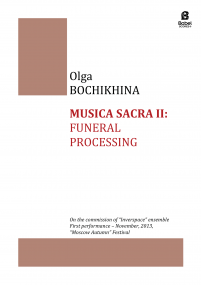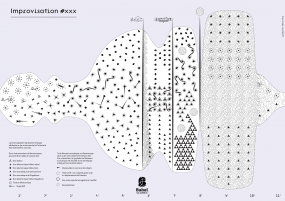SprachSchlag
for percussion and live-electronics
13,39 €
Digital version (+0,00 €) instant download
Printed format (+14,80 € printing and shipping). Colissimo7-14 days aprox.
When you buy a score, you can contact the composer right here!
Specifications
Region
Europe
Estimated Duration
6 - 10min
Date
2000
ISMN : 979-0-2325-0842-9
In Stock
Notes on this piece
Add to a playlist
- Login to create your own lists
SprachSchlag
for percussion and live-electronics
year: 2000
duration: 14:00 min
studio: Klang Projekte Weimar
SprachSchlag is a rhythmic interplay between the instrumental part and the electroacoustic sounds. All rhythms are derived from speech analysis of different languages. The principal instruments are skin (bass drum, tom tom) and vibraphone. They are accompanied by some metal sounds (tamtam, Peking gongs, crotales)
The electroacoustic sounds are live treatments of the percussion sequences and prepared soundfiles, composed from voice and percussion sources.
The electroacoustic part acts as a prolongation of the gestures of the percussionist. The dynamics of the live playing are analyzed by the computer to determine many parameters for the electroacoustic part. It is therefore the percussionist controlling playback aspects within a certain "Event" (see technical notes "how the electroacoustic part works" for detailed explanations).
Even if the live-electronic part is controlled by the playing style of the instrumentalist, the performance needs a second musician, advancing events and controlling the amplification and mix. He has to know the percussion score to "accompany" the instrumentalist.
The electroacoustic part is programmed as a Max/MSP-standalone application for Apple Macintosh. The program contains all sound sequences and the event handling for the live-treatments.
The events are notated as numbers (1-57). The first event serves as initialization.
The musician controlling the live-electronic part is pressing the spacebar of the computer keyboard at every event to activate it.SprachSchlag is a rhythmic interplay between the instrumental part and the electroacoustic sounds. All rhythms are derived from speech analysis of different languages. The principal instruments are skin (bass drum, tom tom) and vibraphone. They are accompanied by some metal sounds (tamtam, Peking gongs, crotales)The electroacoustic sounds are live treatments of the percussion sequences and prepared soundfiles, composed from voice and percussion sources.The electroacoustic part acts as a prolongation of the gestures of the percussionist. The dynamics of the live playing are analysed by the computer to determine many parameters for the electroacoustic part. It is therefore the percussionist controlling playback aspects within a certain "Event" (see technical notes "how the electroacoustic part works" for detailed explanations).Even if the live-electronic part is controlled by the playing style of the instrumentalist, the performance needs a second musician, advancing events and controlling the amplification and mix. He has to know the percussion score to "accompany" the instrumentalist.The electroacoustic part is programmed as a Max/MSP-standalone application for Apple Macintosh. The program contains all sound sequences and the event handling for the live-treatments.The events are notated as numbers (1-57). The first event serves as initialisation.The musician controlling the live-electronic part is pressing the spacebar of the computer keyboard at every event to activate it. Instrumentation
Percussions|electronics|
Recording
Abel Billard - percussion
Score Details
Format - A4 / US Letter
Pages - 44
Pages - 44











